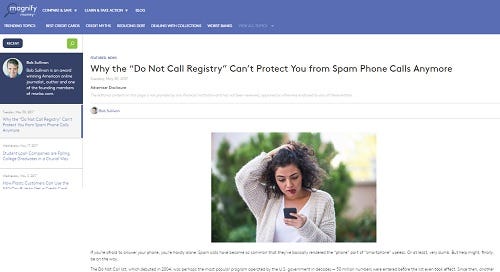Why the Do Not Call list doesn't really work any more

I looked into the problem of robocalling recently for MagnifyMoney.com. Here's the latest: Help is coming, but it's still going to be a while. I'd say more, but my phone is ringing.
Here's a taste of the story. Click to read the rest at MagnifyMoney.com
If you’re afraid to answer your phone, you’re hardly alone. Spam calls have become so common that they’ve basically rendered the “phone” part of “smartphone” useless. Or at least, very dumb. But help might, finally, be on the way.
The Do Not Call list, which debuted in 2004, was perhaps the most popular program operated by the U.S. government in decades — 50 million numbers were entered before the list even took effect. Since then, another 170 million numbers were entered into the registry. U.S. telemarketers quickly learned to abide by the list or face multi-million dollar fines the Federal Trade Commission could impose — and there have been more than 100 enforcement actions.
It worked…for a while. But the combination of internet-based telephones and cheap long-distance calls have made it easy for telephone scofflaws to operate overseas, far beyond the reach of U.S. authorities. Unwanted calls have returned with a vengeance, making some wonder if the Do Not Call list works at all.
How bad is the problem? A firm called YouMail Inc. tries to count the number of robocalls that pester Americans, and the statistics are staggering. YouMail claims that 2.5 billion unwanted calls were placed just in April 2017, equaling 7.7 calls per person.
For fun, YouMail breaks down its data by ZIP code, and found that Atlanta wins for most robocalls received, with about 50 million placed just to the 404 area code in April. Another 35 million arrived at Atlanta’s 678 area code. Houston and Dallas area codes came in second and third. New York City’s 917 area code was fifth, with 29 million.


